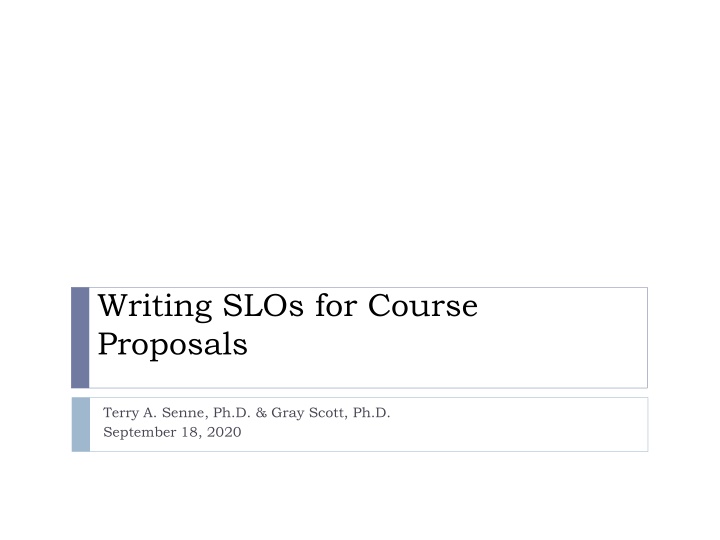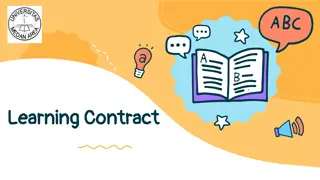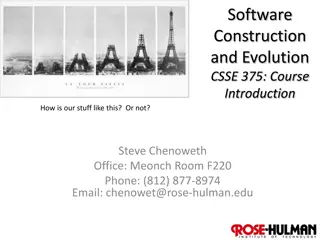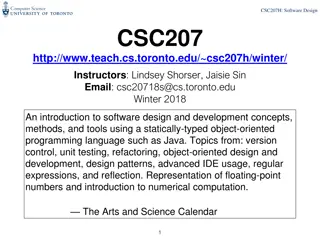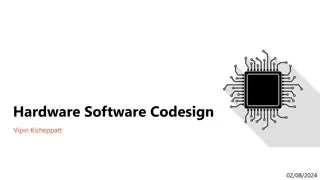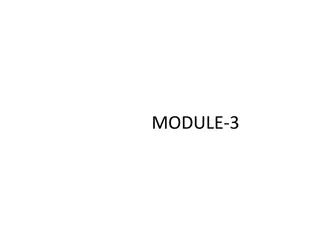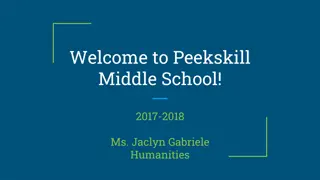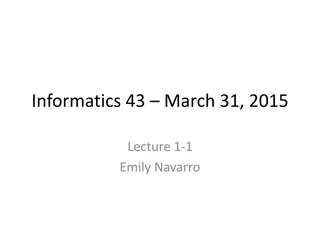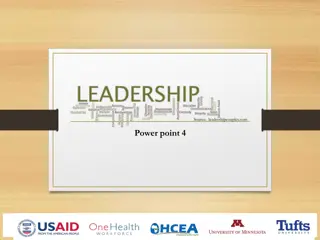Writing Effective Software Leadership Course Objectives
Craft precise course objectives for a Software Leadership program based on real-world assessments and curriculum mapping. Explore activities that enhance students' elicitation skills through practical exercises and feedback mechanisms in computer science and business courses.
Uploaded on Mar 17, 2025 | 0 Views
Download Presentation

Please find below an Image/Link to download the presentation.
The content on the website is provided AS IS for your information and personal use only. It may not be sold, licensed, or shared on other websites without obtaining consent from the author.If you encounter any issues during the download, it is possible that the publisher has removed the file from their server.
You are allowed to download the files provided on this website for personal or commercial use, subject to the condition that they are used lawfully. All files are the property of their respective owners.
The content on the website is provided AS IS for your information and personal use only. It may not be sold, licensed, or shared on other websites without obtaining consent from the author.
E N D
Presentation Transcript
Writing SLOs for Course Proposals Terry A. Senne, Ph.D. & Gray Scott, Ph.D. September 18, 2020
Workshop Outcomes By the end of today s workshop, participants will be able to Provide accurate and specific feedback on course proposal SLOs. Adapt or create one s own course proposal SLOs in accordance with TWU guidelines.
Scenario: The computer science department and the School of Business have created a small certificate program in Software Leadership. The program has three required courses and one choice of two courses. Its four program objectives are usually summarized by faculty as Management, Coding, Elicitation, Documentation. Activity A Big-Picture Scenario
In AY 2018-19s capstone assessments, the percentage of students meeting each objective were as follows: CAPSTONE ASSESSMENTS Meets Exit Competency Management 84% Elicitation 33% Documentation 77% Coding SLO 2 (Elicitation): By the end of the program, successful students will be able to clearly and accurately describe client software needs based on interviews with those clients. 92% Activity A Big-Picture Scenario
Software Leadership Curriculum Map Software Leadership Management Elicitation Documentation Coding CSCI 301 (required) 3 3 CSCI 302 (required) 2 2 2 CSCI 303 (choice A, 20%) 2 3 1 CSCI 304 (choice B, 80%) 2 1 3 Activity A Big-Picture Scenario BUS 302 (required) 3 1 3: Primary emphasis, 2: Secondary emphasis, 1: Tertiary emphasis.
Software Leadership: Elicitation Activities by Course CSCI 302: Lectures on principles of interviewing Quizzes on those principles. Low-stakes, practice in-class: Students pair up and trade off being "client" and "interviewer." Clients receive a handout describing their needs. CSCI 303: Students regularly practice writing elicitation documents based on pre-recorded interviews. Practice documents are regularly reviewed and revised in class. For final project, student teams interview faculty playing client according to a trained script. The interview sessions are recorded. Teams create elicitation documents. Teams with weak elicitation documents meet with faculty to review the recorded interview and determine where they went wrong. BUS 302: Final project is based on pre-recorded client interview. Elicitation documents included in appendix of final project and scored for factual accuracy. The same assignment and the recorded interview for this project have been used consistently for four years. Activity A Big-Picture Scenario
Discussion: Why did we start with this activity? Activity A Big-Picture Scenario
Making a SLO 1. Principles of SLO Cooking 2. Action Verb Levels & Coloring Outside the Lines 3. Workshop on Your Own SLOs
The professor will provide opportunities for active learning through three experiential field trips. Students will practice brainstorming, outlining, peer review, and revision. By the end of the course, successful students will appreciate Shakespeare. Activity Evaluating SLOs
Principles of SLO Cooking, Part 1 A good SLO focuses on what a student successfully completing the class should be able to do.
Principles of SLO Cooking, Part 1 A good SLO focuses on what a student successfully completing the class should be able to do. Not a teacher!
Principles of SLO Cooking, Part 1 A good SLO focuses on what a student successfully completing the class should be able to do. That is: At the end of class.
Principles of SLO Cooking, Part 1 A good SLO focuses on what a student successfully completing the class should be able to do. This is the tricky one: 1. Not knowledge, but what can they do with the knowledge.
Principles of SLO Cooking, Part 1 A good SLO focuses on what a student successfully completing the class should be able to do. This is the tricky one: 1. Not knowledge, but what can they do with the knowledge. 2. Not a process, but what that process enables them to accomplish.
Principles of SLO Cooking, Part 1 A good SLO focuses on what a student successfully completing the class should be able to do. This is the tricky one: 1. Not knowledge, but what can they do with the knowledge. 2. Not a process, but what that process enables them to accomplish. In other words, what exit competencies should students possess?
Principles of SLO Cooking, Part 2 A good SLO is measurable detailed and specific active
Principles of SLO Cooking, Part 2 A good SLO is measurable detailed and specific active Put another way: Can the learning, as it s framed here,be identified or observed? (It s difficult to tell whether someone honestly appreciates literature, for instance.)
Principles of SLO Cooking, Part 2 A good SLO is measurable detailed and specific active Other types of aspirations, like goals, might be general and broad ( We want students to be life-long learners ), but a SLO points directly at something that the student should be able to do.
Principles of SLO Cooking, Part 2 A good SLO is measurable detailed and specific active The key here is the verb: In general, you want an action verb, like the ones categorized in Bloom s Taxonomy. Verbs like define, explain, evaluate, create, compare, design.
Components of Student Learning Outcomes It s simple Just remember your ABCCs! A = Actor (sometimes referred to as the stem) Identifies who will do the behavior, e.g. The studentwill be able to B = Behavior (sometimes called an action verb) Identifies what the student will be able to do. Use Bloom s Taxonomy. C = Conditions (specific details) Identifies context/setting and/or conditions under which the behavior will occur. C = Criteria (often signified by an adverb) Identifies the minimum acceptable level of performance.
Components of Student Learning Outcomes It s simple Just remember your ABCCs! A = Actor (sometimes referred to as the stem) Identifies who will do the behavior, e.g. The studentwill be able to details that they infringe on academic freedom of faculty. Conditions shouldn t be so specific about assignment B = Behavior (sometimes called an action verb) Identifies what the student will be able to do. Use Bloom s Taxonomy. C = Conditions (specific details) Identifies context/setting and/or conditions under which the behavior will occur. C = Criteria (often signified by an adverb) Identifies the minimum acceptable level of performance.
Components of Student Learning Outcomes It s simple Just remember your ABCCs! A = Actor (sometimes referred to as the stem) Identifies who will do the behavior, e.g. The studentwill be able to B = Behavior (sometimes called an action verb) Identifies what the student will be able to do. Use Bloom s Taxonomy. Criteria shouldn t be so specific that they infringe on academic freedom related to grading. C = Conditions (specific details) Identifies context/setting and/or conditions under which the behavior will occur. C = Criteria (often signified by an adverb) Identifies the minimum acceptable level of performance.
By the end of the program/course/lesson, students will be able to Select the most appropriate investigative methods or information retrieval systems for accessing needed information. 1. Activity Is This SLO measurable? Why or why not?
Sample Identification of SLOs Components By the end of the program/course/lesson, students will be able to Select the most appropriate investigative methods or information retrieval systems for accessing needed information. Actor Students Behavior Select investigative methods or information retrieval systems Conditions For accessing needed information Criteria/Criterion Most appropriate This SLO is measurable since it contains all 4 components.
By the end of the program/course, students will be able to Effectively communicate interpretations of theatrical material in one or more of the following media: orally, in writing, and/or through dramatic performance. Activity Is This SLO measurable? Why or why not?
Blooms Taxonomy of Educational Objectives Action verbs help to ensure that a student learning outcome is measurable. Bloom s Taxonomy is a hierarchical design of ways of thinking (action or performance verbs), and classifies learning/cognition into 6 levels from less complex to more complex. Level 1 Know Level 2 Understand * Level 3 Apply Level 4 Analyze Level 5 Evaluate Level 6 Create Due to the hierarchical design of the taxonomy, action verbs from lower levels of the taxonomy can be inferred at higher levels of the taxonomy.
Rules of Thumb Action verb selection Avoid use of verbs like know, understand, recognize, value, demonstrate, or appreciate, unless you describe the student performance actions that will indicate their knowledge, recognition, value, appreciation or ability to demonstrate. Note that once you ve described the performance actions necessary to indicate those qualities, you may discover you no longer need the weaker verbs. Keep SLOs simple best to use one action verb per SLO.
By the end of the program/course/lesson, students will be able to Recognize appropriate concepts and theories of motivation to achieve group and organizational goals Activity How can we make this SLO more measurable?
What levels of action verbs are appropriate for designated course levels? SACS-COC Accreditation Principles Section 9.6 states that, Post-baccalaureate professional degree programs and graduate degree programs are progressively more advanced in academic content than undergraduate programs How can you determine which action verbs are appropriate given a designated course level?
What levels of action verbs are appropriate for designated course levels? IN GENERAL: Higher course level = higher-level action verbs from Bloom s Taxonomy One would expect 3000 and 4000-level course SLOs to include action verbs derived from the higher levels of Bloom s Taxonomy (Levels 4-6). Graduate course SLOs would typically reflect action verbs found at the most complex levels of the taxonomy (Levels 5 & 6). But not always!
When You Need to Color Outside the Lines Low-level verb, but advanced predicate or object The student will be able to explain quantum mechanics in a two- page essay. (It s tougher to identify the cause of a symptom than to create a mud pie.)
When You Need to Color Outside the Lines Same verb, different objects at each level of a sequence The student will be able to write a personal narrative. The student will be able to write a business letter. The student will be able to write a literature review. The student will be able to write a grant proposal.
Clearly explain the mechanisms of development from different theoretical perspectives. Accurately define developmental change. Accurately identify and describe theories and models which describe the developmental process. Clearly articulate strengths and limitations in theories and approaches that explain, predict, and describe the developmental process. Appropriately apply theoretical knowledge to in-depth investigation of a particular topic associated with development in childhood or adolescence. 1. 2. 3. 4. 5. Activity Evaluating SLOs
Select 1-2 student learning outcome(s) from your syllabus. Determine whether the SLOs are measurable as written. Do the SLOs contain all of the ABCCs? Revise SLOs as needed so that all components (ABCCs) of selected SLOs are included and are measurable. Pairs Check: Provide feedback to a colleague on the revised SLOs he/she has drafted switch roles Activity On Your Own
Who will share his/her draft student-learning outcome and an improved version of the SLO? Activity Examples to Share
Contact Information Terry Senne, Director of Academic Assessment tsenne@twu.edu (940) 898-3029 Gray Scott, Assistant Director of Academic Assessment grayscott@twu.edu (940) 898-2327
The Design-Down Approach to Constructing a Course Always start with the end product (SLOs) in mind. Consider the following questions to begin the process of constructing SLOs: What intended student learning is critical to program/course/lesson content knowledge? And, what will students be able to do with content knowledge gained?
Consider the following SLO: Clearly differentiate and apply early childhood theories. What taxonomy level is the action verb differentiate? What taxonomy level is the action verb apply? Are both action verbs needed? Why or why not? Activity How could the above SLO be restated?
Closing Thoughts Core course proposal submissions Course proposal submissions for Global Perspectives designation TWU CIMS course proposal submission approval process The buck stops here. Academic Assessment Course SLOs are reviewed first. If proposed course SLOs do not meet the TWU Guidelines as submitted, the course proposal will be sent back to the department for SLOs revision. Comments for the good of the group
